How to optimize your steemit blog for Google and encourage organic traffic [7 steps tutorial]
We have been talking a lot about ways to penetrate the attention economy, steemit´s need for growth and possibilities to bring new users to the platform.
There is one tool which might be a solution to all of these questions: Search Engine Optimization.

The power of content optimization
About 8 years ago I was working for the German publisher Condé Nast, being in charge of its online sales production team (condenet.com). My team managed all the online advertisement published on the websites of GC, VOGUE, Glamour, myself and some other smaller (fashion & beauty) brands, including editorial / content management, traffic management and Search Engine Optimization (SEO).
That´s where I learned how to push content on Google. I perfectly remember my very optimized content and what happend to it: I had tuned an advertorial (editorial ad) about the famous shoe designer Manolo Blahnik, according to the SEO rules we had learned during an internal workshop at Condé Nast. 7 days after its publishing date it appeared on the very first page of search results, not having paid even 1 Cent to Google.
From that day I knew how powerful content optimization can be. Today I would like to share my knowledge with you.
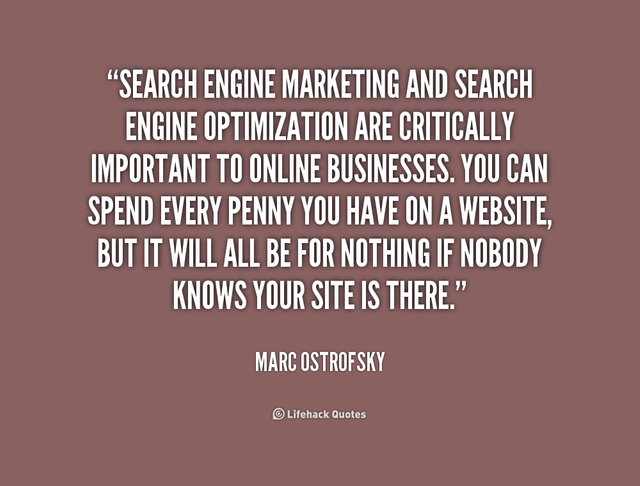
Why do we need organic traffic?
Organic traffic is traffic that comes to our blogs as a result of unpaid search results.
Presumably most of us are mainly focussing on gaining attention within the network of steemit at the moment. What matters to us - from an economical point of view - are upvotes, comments and reblogs which can only be done by users who have already signed up to the platform.
Regardless, focussing on ways to generate traffic coming from the outside of steemit´s borders will be contributive just as well in the long term. If you saw your blog as a brand, a business to establish in a new market segment, you should consider all possibilities to improve its attention within that defined segment. Search Engine Optimization could be key to your own interests but also the interests of the whole platform.
In the end traffic means attention means value.

Preparation: the keyword setting
Important lesson: SEO starts BEFORE you write even a word of content. Optimization works like everything in business: do it properly or not at all.
Imagine that you were going to write about blogging for steemit. First of all you need to check the volume of content already existing to that keyword.
Checking search volume
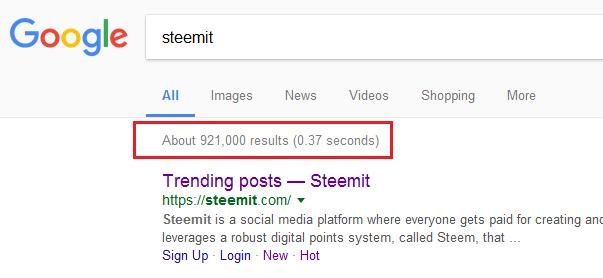
Currently there are 921,000 search results (red box above) for the keyword steemit on Google. That´s quite a lot. The bigger the search volume, the more complicated to stand out. Imagine that to get on the first page of search results you would have to leave behind almost 1 million articles already written about steemit.
Specifying your keyword
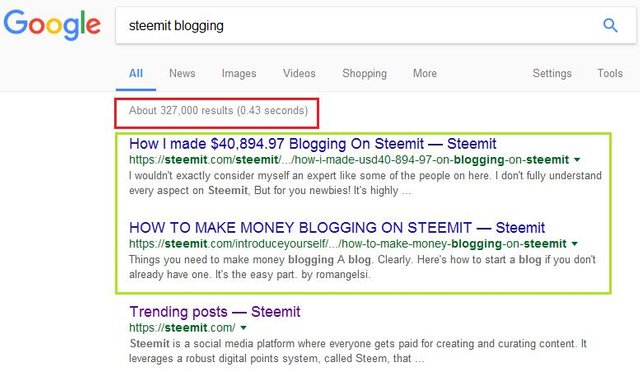
Thinking about your own search pattern you know that we rarely search for a single word. If you want to get precise search results than the keywords you type into the search field have to precise as well. Keeping with our example: for steemit blogging you would currently get around 327,000 search results (see red box above). That is much 'better' than 921,000 from a optimizer´s point of view. Congrats: the number of your content competitors hast just decreased by aproximately 60%.
Interesting additional information: there are two articles published on steemit which made it to the top 2 search positions (see green box above) for the key word steemit blogging. These surely will be your no. 1 competitors during your optimization process, and it would be recommendable to study them in order to overtake them.
Lesson learned: a keyword can be composed by more than one word/term!

Creating the final keyword set
Later we will learn that we need around 3-4 keywords for an article.
steemit blogging will be our main keyword (key 1). Besides we need 2-3 additional keywords, which are close to the main keyword as regards to contents. My suggestions would be:
key 1: steemit blogging (main keyword)
key 2: paid content
key 3: social network
Lesson learned: The Google search algorithm includes semantical variations of keywords. If steemit blogging was your keyword, the algorithm automatically includes similar words like blog, blogger, etc. That is why you don´t have to include these semantical 'brothers and sisters' in your keyword set.
8 steps of keyword optimization
Now that you have set the keywords, you can start with the content production and its optimization.
Lesson learned: SEO is nothing you do AFTER having produced a certain piece of content, you have to implement it parallelly.
The following steps are sorted according to their priority from an optimization point of view - starting with the most important one.
1. - The title tag
The <title> tag is automatically created by the title (topic) of your article (not to mix up with the headline, which we will come to know later).
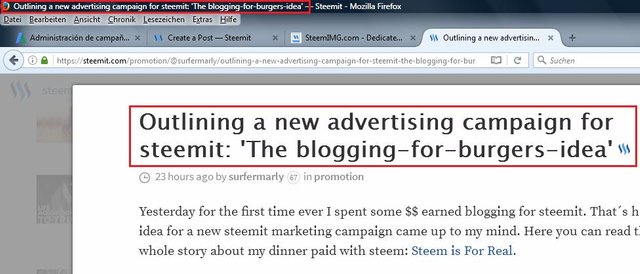
I have visualized that by one of my recent published articles (see screenshots above).
The title of the article (here: Outlining a new advertising campaign for steemit: 'The blogging-for-burgers-idea') is automatically included in the <title> tag of your html sour-code.
That´s the relevant part of the code:
<title data-reactid="45">Outlining a new advertising campaign for steemit: 'The blogging-for-burgers-idea' — Steemit</title>The title tag is the most important tag when it comes to keyword optimization.
Keeping with our example: If you wanted to optimize an article with the main keyword steemit blogging, you would have to introduce that keyword in your <title>, preferring to have it at the very beginning of the title.
Example: Blogging for steemit: My experiences with the new blogger´s network
Remember: The Google algorithm consideres semantical similarity. You don´t have to put the parts of your main keyword in the exact order, and it also doesn´t matter if they are not consecutive (in the example shown above we have the word for inbetween).
2. - Keywords inside the content
The perfect keyword concentration is about 2-5%. That means that every 50 to 20 words you should copy your main keyword. The keyword should be perfeclty distributed along the article, having it at least nicely represented at the beginning, the middle and the end.
Furthermore, try to include your second and third keywors as well. In our example:
key 2: paid content
key 3: social network
This is a firefox plugin called 'search status' which helps you to count the number of keywords already existing in your content: https://addons.mozilla.org/de/firefox/addon/searchstatus/
If you write a keyword optimized article you have to partly forget what you have learned about 'good style'. Search engines don´t appreciate that, they simply count your keywords.
Lesson learned: keyword optimization is not aesthetically beneficial to your content :-)
3. - Semantical environment (relation keyword vs. content)
To avoid keyword abusement, the Google algorithm doesn´t support simple keyword spreading.
Your content has to be congruent. The means that you cannot write about your recent diet program when your article is supposed to be optimized for the keyword steemit blogging. Google checks also the semantical environment of your keywords, so you can´t fool anybody here.
Using your second and third keyword will also help you to maintain your content congruent here.
4. - The h1 tag
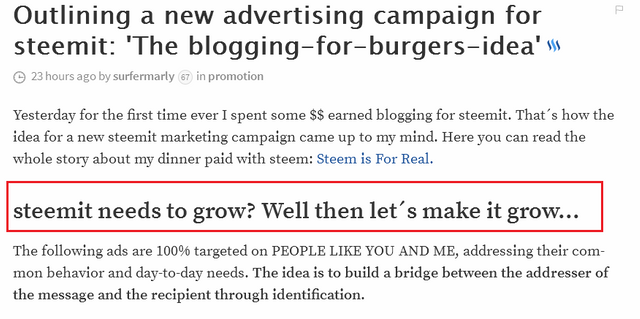
The <h1> tag describes the first headline (headline no. 1).
Lesson learned: the <h1> tag can be used ONLY ONCE in the whole article!
If you are using the steemit editor to create your article, we are talkig about the format Headline Large.
That´s a Headline Large | <h1> tag
In the source-code it looks like that:
<h1>steemit needs to grow? Well then let´s make it grow... </h1>In our example you would include your main keyword (here: steemit blogging) in your headline 1, for example like that: 7 experiences blogging for steemit
5. - Keywords in further headlines
Besides the <h1> tag which we have just mentioned, you have to include the keyword also in your following headlines. So the headlines would all look more or less the same?!?! As I said: optimizing content for Google won´t make you win a content beauty contest. That´s the price you have to pay.
Try to smoothly include your main keyword in the <h2> and <h3> tags, for example like that:
How I started blogging for steemit
A steemit bloggers lessons learned
Blog style on steemit
Remember that you can play with semantically similar words. The three examples shown above include our main keyword steemit blogging, but making use of words which are related with each other: blogging, blog, bloggers, etc.
That might help you to not hardly break with your style.
6. - Bold characters
Highlight some of the keywords you have distributed along your content (see no. 2 of the list). It sounds too easy but it will definitely help to underline the importance of the part of the content for Google´s algorithm.
7. - Meta tags (something to consider for future steemit versions)
It would be awesome to have a possibility to edit meta tags of our content. I am not sure if there is any editor working for steemit which enables us to do that. The editor provided on steemit (the one we all know) doesn´t include that functionality.
If we were able to manipulate the meta tags of our articles, we could include our keywords here:
<meta name="keywords" content="key 1, key 2, key 3">
Since it appears at the end of my list, it hasn´t a huge influence on our optimization success, but as I mentioned on the beginning of my article, SEO works like all other aims in business: do it properly or don´t do it at all.
If there was a wish list for future implementations on steemit, 'enabling to edit meta keywords' would be one of mine...:-)
Thanks for your attention!
That was a lot of text, I hope it was worth reading.
If you followed all of the described steps, your content might appear on Google´s first result pages when searching for your defined main keyword after 7 to 14 days. The Google algorithm needs some time to find new content, analyze and index it accordingly, that´s why it won´t be listed immediately.

I hope you enjoyed my little tutorial and it will help to encourage steemit´s organic traffic growth. Our blogs are small pieces of a huge puzzle. If we bundled our forces and priorized the importance of external traffic, we would all profit by it in the long term. Traffic will bring new users, thus increase value.
If you have questions, doubts, comments - please feel free to post them replying to this article.
Wishing you all a nice steemy Sunday!
Marly -
May our great steemit blogs be found out there in the search engines´ jungle...

Picture source title (Google): http://ez.no/
Picture source quote SEO: http://quotes.lifehack.org/
Picture source brand Forbes quote: http://tippingpointus.com/
Picture source guy sitting at table: Pixabay.com
Picture source animated GIF: http://24.media.tumblr.com/
Picture source flag: https://s-media-cache-ak0.pinimg.com/

This seems like yet another interesting and helpful post @surfermarly. I've bookmarked it to read more closely later.
Now first, time to make dinner! (Lasagne, yum <3)
Yummy! Italian food it simply the best, enjoy your meal :)
You are welcome, I am glad if I can help. One for all and all for one ...
I didn't get all the way through this so I am leaving a comment to come back to it. Thank you for posting this and I might actually do something with my google+ account now ha.
@Timbo
I have started a Google AdWords campaign for my steemit blog a few days ago. But it´s tremendously expensive. That was the moment when I remembered that I actually learned how to do SEO for free one day... and started to prepare this article.
Thanks for your comment and come back to read the full article. You won´t need a google+ account btw, it can be all done magically on an editorial level :-)
Oh really? Hmm, then in that case I will for sure sit down and look over this in detail when I have the time.
From what I am already able to get this is an on point presentation/tutorial.
Thank you again my friend,
you are welcome and enjoy your Sunday eve :-)
You too my friend!
Goshhhh! Lots to take in! This could be the most single important article ever for those who want to really increase their visibility!
Would you mind if I try to translate to Spanish?
Thanks for your kind words, I am glad you liked it :)
Right now unfortunately I don´t have the time to do any translation since I´ve started writing a book. Maybe within some weeks.
My fault! I mean if I could do the same post translated into Spanish...
Excepcionalmente si ;-) Normalmemte hago mis propias traducciones pero a falta de tiempo lo puedes hacer encantada, siempre y cuando a) seas nativo y b) incluyas el enlace del articulo original (inglés) y menciones que el autor es @surfermarly justo al principio de la traducción.
Eres español nativo?
Marly -
Great post! What would really be awesome is a tool or app that would help you optimize a #steemit post for SEO, similarly to how YOAST optimizes WordPress posts. This post with steps is a great start!
I couldn´t agree more! Thanks for your great support, I really appreciate that!
Following you back now :)
Absolutely brilliant post with superb information. Many thanks. Upvoted and following
Thank you very much!!! I am glad you liked it.
One for all and all for one :-)
Good advice, I never really thought about SEO for my blog posts. However I probably should as it could drive more people to find out about the platform. Good for me and good for steemit.
Me neither!! I was focussed on raising my rep here and completely forgot about generating external traffic. I think we should care about both...
Thanks for your feedback and time :)
Thanks for sharing your expertise:
https://twitter.com/Soul_Eater_43/status/821030702439419904
Oh cool! Thanks for the tweed and your support, I feel really honored :)
You're welcome:)
That's quite interesting, I might tweak my recipe posts a little!
Thank you @meesterboom! I think we all should pimp our content a bit (I haven´t done it either by now).
If we bundled forces, we could bring a LOT of traffic here.
I totally agree!!!
i use to have good listings on google image search which lead to my old Steemit posts but after checking just now they dropped.
Oh yeah! That´s one thing I actually missed to mention in my post, thanks for adding it!!!
That´s the way it works:
Thanks for stopping by and commenting :)
Thanks for the 'primer'! I've been "holed up" (actually relaxing) in my 'cabin in the woods', working out paper drafts for my first post of the "Loose Change Project". @loosechange (no posts yet) I appreciate your content, as I've been reading up on steemit & blogging style, content & writing in general.
What will your Loose Change Project be about if I may ask...?
Thanks for your feedback, I am glad you´ve found the way through the woods to my blog :-)
Launched it. (about an hour ago) Your can read it at @loosechange. Thank you again for your post. I most likely will read this about 5X to get the full 'gist' of the content.
Oh cool I will have a look at it in the afternoon!
Sure, that's nothing you learn in an hour. But I would recommend to just try it step by step while preparing a new post (open the tutorial in one tab and create a new article in another tab). It seems much more complicated than it really is ;-)
Steem on!